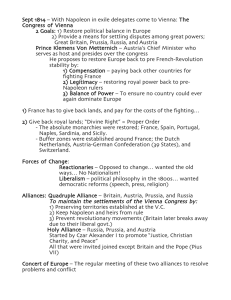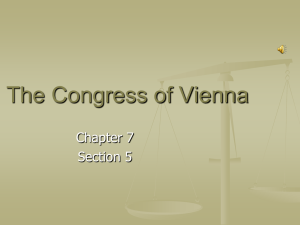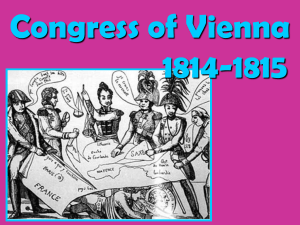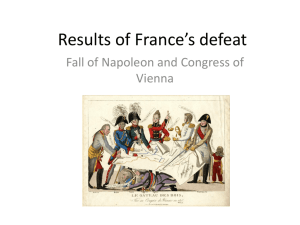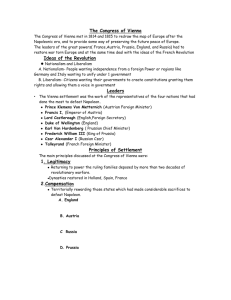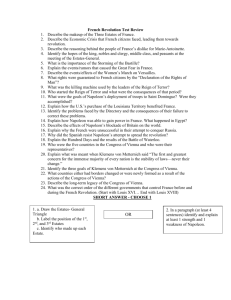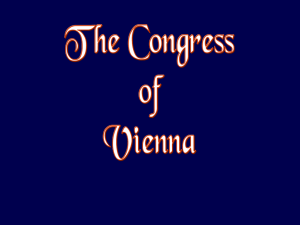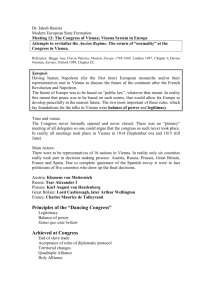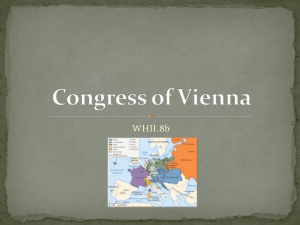The Concert of Vienna - Oak Park Unified School District
advertisement
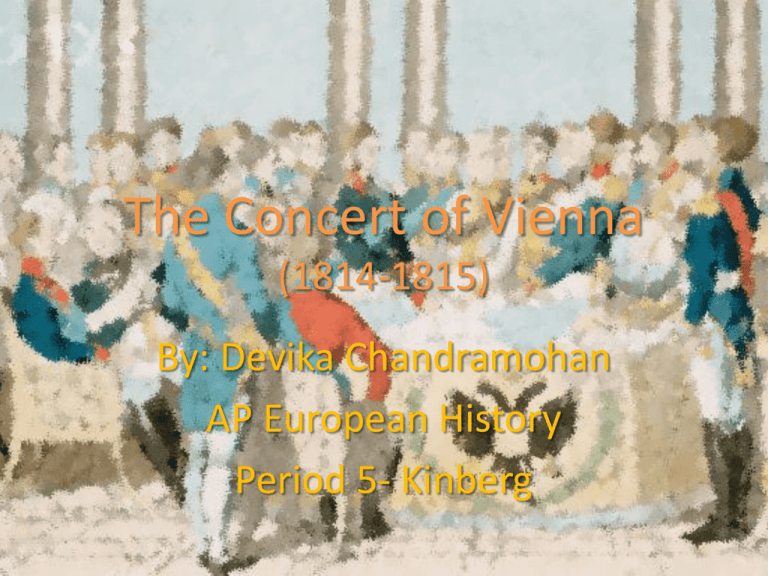
The Concert of Vienna (1814-1815) By: Devika Chandramohan AP European History Period 5- Kinberg Background Click to watch a brief video on Napoleon • Napoleon: – Failed in his invasion of Russia – Britain, France, Austria, Sweden, and Russia against him – Treaty of Chaumont (Mar. 10, 1814): Great Britain, Russia, Austria, and Prussia agree to hold peace meeting later on – Apr. 12, 1814: renounced his throne – Exiled to island of Elba (“Landing”) Issues to Be Solved “Legitimacy, Security, Compensation” • Control France so that it will never expand like it did under Napoleon • Reestablish monarchies • Balance of powers • Distribution of lands (Streich) Who Participated? Most important person Robert Stewart, Viscount Castlereagh (Great Britain) Prince Klemens von Metternich (Austria) --Conducted the Congress Prince Karl August von Hardenberg, Chancellor (Prussia) Tsar Alexander I (Russia) Charles Maurice de Talleyrand-Périgord Prince of Talleyrand (France) Along with most of the other powers in Europe, who were not given a major role… Dealing with France… • First Peace of Paris (May 30, 1814): Established Louis XVIII King of France= reestablishment of Bourbon monarch Copy of Treaty of Paris (“Copy”). – Regained some colonies (like in India) – Had to abolish slavery – Allowed to keep artwork Napoleon had taken by force • Also known as Treaty of Paris France’s Land • Reduced size of France to slightly larger than what it was in 1792 (Chambers 644). • Surrounded by weak powers= prevent weak powers from being taken over by France – Kingdom of Netherlands – German Confederation (dominated by Austria) – Switzerland – Kingdom of Sardinia (“The Congress”). Map of Europe, 1812 (“Map”). Notice the change in France’s size, as well appearance of new independent kingdoms. Map of Europe, 1815 (“France”). Dealing with other lands… • Tsar Alexander I wanted Poland • Prussia agreed to allow it if they got Saxony • Great Britain and Austria saw this as dangerous to balance of powers (Snyder). Kingdom of Poland before partition (“Polnische”). • Talleyrand saw conflict as opportunity to get France involved • Proposes: – Russia get smaller piece of Poland – Prussia get smaller piece of Saxony – If they don’t agree, Britain and Austria should make alliance to force them to agree (actually made Jan. 3, 1815 but never used) • Feb. 11, 1815: Poland partitioned to Austria, Prussia, Russia – Solution raised France’s power in Congress until someone returned… (Snyder) (“Russian-Ruled”) • Russia received Finland from Sweden • Sweden received Norway from Denmark • Great Britain obtained Malta, Ceylon, the Cape of Good Hope colony, and Dutch Guiana • Austria gave up Netherlands and got Salzburg, the Tyrol, the Italian lands of Lombardy and Venetia and districts along the Dalmatian coast (Snyder) Napoleon Returns… • Napoleon escaped Elba and returned to regain his empire in March of 1815. • Campaign only lasted 100 days, thanks to the Duke of Wellington. • Exiled to St. Helena • June 9, 1815: Congress signed Final Act of the Congress of Vienna (basically finalizing changes made) (Chambers 644). Click to watch a short clip on the Battle of Waterloo (Lawrence) Lord Arthur Wellesley, Duke of Wellington Second Peace of Paris • France’s support of Napoleon’s return = Congress tougher on France • Talleyrand made prime minister of France, but France excluded often in decisions of Congress • Prussia wanted harsh treatment of France – Most others wanted moderate approach • Castlereagh convinced everyone that “security, not revenge” would promote peace. Revenge= rebellion from France – Suggested indemnity (700 million franks to Allies) and return of artwork – Talleyrand resigned, replaced Armand Emmanuel du Plessis, Duke of Richelieu, who accepted treaty • Reduced France’s landholdings even more • Signed on Nov. 20, 1815 (Snyder) Additional Alliances… • Holy Alliance – Proposed by Tsar Alexander I – Countries conduct affairs according to Christian beliefs – Ottomans (not Christian), Pope Pius VII (didn’t want a deal with Protestants), and British (didn’t want to make any commitments to the Continent) refused. – Signed by Austria, Russia, and Prussia on Sept. 14-26th, 1815 – Rather worthless, but did look good in eye of the morality of the public Three Sovereigns of the Holy Alliance (“Three”). (“The Holy”) • Concert of Europe – Called by Metternich – Agreement between major powers of Europe to act together in order to maintain conservatism – Prevent revolutions – Did not work out well • Most powers acted on their own – Ex: Britain and France declare war on Ottoman Empire even though Metternich did not approve • Ties between nations breaking down slowly (Chambers 646) Successes of Congress of Vienna • No major war between European powers for another century • Established diplomatic rules used to this day • Free use of international waterways • Brought back conservatism • Balance of power maintained (Chambers 644) Critics • Delegates spent a lot of time with entertainment – Imperial Masquerade – Performances – Parades – Exhibitions (Spiel 89-130) (“Le Congres”) • Considered it “the occasion during which aristocrats danced while foisting reactionary regimes on the people of Europe” (Chambers 646). • Changed borders without even considering nationality and the people • Took away many rights people had received during Revolutionary era • Still a constant fear of revolution • Small groups still working towards constitution and freedom in their nations (Chambers 646-652) Metternich, at the center of attention, as usual. Congress of Vienna (“Congress”). Works Cited Congress of Vienna. Digital image. History Scops. Blogspot, 20 Apr. 2011. Web. 17 Prince Klemens von Metternich. Digital image. Shrouded Eagle. N.p., 2009. Web. Dec. 2012. 15 Dec. 2012. Copy of the Treaty of Paris. Digital image. Bienvenue à Grand Baie, L'Île Maurice. Robert Stewart, Viscount Castlereagh. Digital image. ABC Sydney. ABC, 21 Nov. Legekko Info Ltd, n.d. Web. 18 Dec. 2012. France After Congress of Vienna. Digital image. The Web Site of Sandra Soucy. 2012. Web. 15 Dec. 2012. Russian-Ruled Kingdom of Poland. Digital image. Worldology. Worldology, LLC, 26 N.p., 20 Apr. 2007. Web. 16 Dec. 2012. Nov. 2012. Web. 17 Dec. 2012. Gerstenberg, Christel. Engraving of Congress of Vienna, 1814-1815. Digital image. Snyder, Daniel E. "A Brief History of the Congress of Vienna." A Brief History of the Corbis. N.p., n.d. Web. 15 Dec. 2012. Landing in Elba. Digital image. James Smith Noel Collection. Louisiana State Congress of Vienna. Pinecrest School, 5 Nov. 2010. Web. 15 Dec. 2012. Spiel, Hilde. The Congress of Vienna; an Eyewitness Account,. Philadelphia: Chilton University, n.d. Web. 15 Dec. 2012. Lawrence, Thomas. The Duke of Wellington. Digital image. Today in Irish History. Word Press, 1 May 2012. Web. 15 Dec. 2012. Book, 1968. Print. Streich, Michael. "Goals of the Congress of Vienna 1814-1815." Suite101.com. Community 101, 3 Feb. 2009. Web. 16 Dec. 2012. Le Congres. Digital image. Markville History. Markville Secondary School, n.d. Web. "The Holy Alliance (1815)." Russian Nobility. Russian Nobility Association in 18 Dec. 2012. Map of Napoleon's Conquests by 1812. Digital image. The Web Site of Sandra Soucy. N.p., 20 Apr. 2007. Web. 16 Dec. 2012. Polnische Teilung 1793. Digital image. T. Griesbacher, n.d. Web. 18 Dec. 2012. America, Inc., n.d. Web. 17 Dec. 2012. The Congress of Vienna. N.p.: Classzone, n.d. PDF. Three Sovereigns of the Holy Alliance. Digital image. Memo. Media Welcome, 2008. Web. 17 Dec. 2012. Prince Karl August von Hardenberg. Digital image. 4th Coalition. N.p., n.d. Web. 15 Tsar Alexander I of Russia. Digital image. Skepticism.org. N.p., n.d. Web. 15 Dec. Dec. 2012. 2012.
